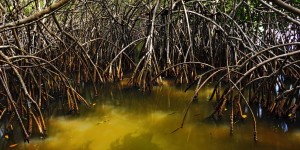 If there’s one plant the Everglades is know for, it’s its mangroves. You know those trees whose roots stick above the water and look like long fingers? Yup, those are mangroves and they are extremely important to the ecosystem of the Everglades. They are magical in appearance and when you glide by them on an airboat tour, you feel like you’re in a fairytale or enchanted land.
If there’s one plant the Everglades is know for, it’s its mangroves. You know those trees whose roots stick above the water and look like long fingers? Yup, those are mangroves and they are extremely important to the ecosystem of the Everglades. They are magical in appearance and when you glide by them on an airboat tour, you feel like you’re in a fairytale or enchanted land.
Currently, Florida is home to about 469,000 acres of mangrove forests. The Everglades is home to largest mangrove forest in North America. Mangroves thrive in tropical and subtropical climates. These trees produce seeds that drop and get carried away by water or winds, and the mangroves will grow wherever the seeds land.
There are about 50 species of mangroves. Three species of mangroves are found in Florida: the red mangrove, the black mangrove, and the white mangrove.
The most well-known, and easily seen in the Everglades, is the red mangrove. It’s the mangrove we were describing above. It’s a salt-tolerant tree that grows in areas with low-oxygen soil. They can take freshwater from the saltwater to survive. These mangroves have prop roots that make them look like they’re standing on the water. With these roots, the forests can handle rising tides in-and-out of the Everglades. The roots are reddish in color.
The black mangrove sits at a higher elevation than the red mangrove. This mangrove has finger-like projections that protrude from the soil around the trunk of the tree.
The white mangrove can be found at the highest elevations of these three species. This mangrove’s roots do not show; it has light, yellow-green leaves.
Mangroves help protect the Florida coastline, the Everglades, and in turn, help protect human developments. The mangroves’ roots stabilize the coastline and higher lands by reducing erosion. These trees also block winds, waves, floods, tides, and storm surges from damaging the land – think of them as a fortress wall. The bigger, wider, and thicker a mangrove forest, the more protection to the environment it can provide.
Not only can mangroves protect land, they can also filter water and keep water quality high.
Another major benefit and quality to mangroves is that they also provide a habitat for a variety of birds and marine life. Many fish and animals use the mangrove forests as protection, shelter, or a place to find food.
Unfortunately, mangroves and mangroves forests are disappearing. According to American Forests, the oldest national conservation organization in the country, almost half of the world’s old-growth mangrove forest have disappeared in the past 50 years. Humans are a major cause to the loss of the mangrove forests due to industrial shrimp farming and coastal development.
Now, in Florida, state and city laws have been established to protect these forests, which are a key role in Florida’s ecosystem. It’s important we do what we can to protect these plants as they are key to not only the Florida ecosystem, but the protection of us!
Ride Through the Mangroves on an Airboat
Do you want to see the beautiful, protectors known as mangroves up close? An airboat tour can take you up-close-and-personal to these plants!
An airboat ride through the Everglades can allow you to see vegetation and animal life you won’t see anywhere else!
Book an airboat tour with Captain Mitch’s Airboat Tours by calling 800-368-0065 or visiting our Everglades Airboat Tours page. Ask us about the mangroves!
We are open seven days a week 8:30 a.m. to 5 p.m. If paying by cash, adults cost $40 (plus tax) and children 12 and under cost $20 (plus tax. If paying by credit card, adults cost $45 (plus tax) and children cost $25 (plus tax).






